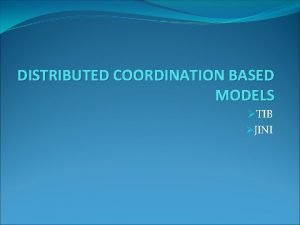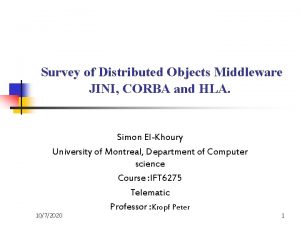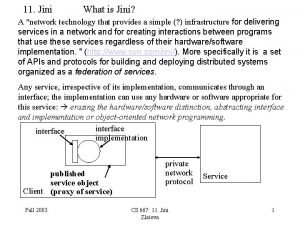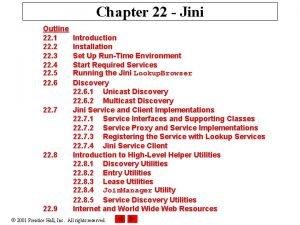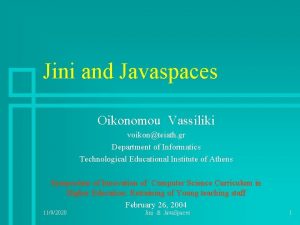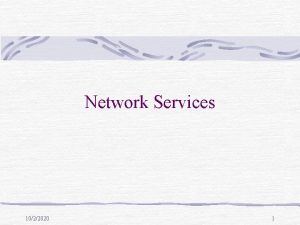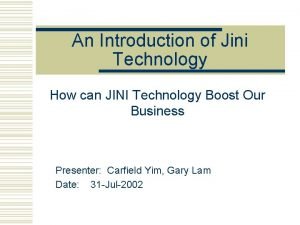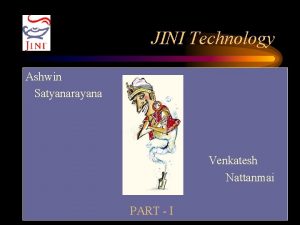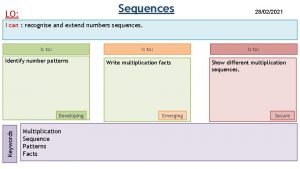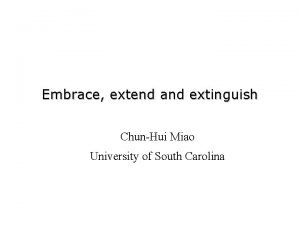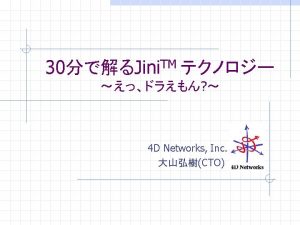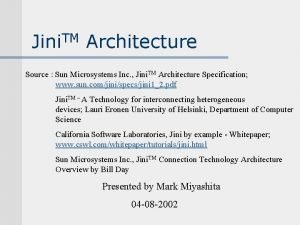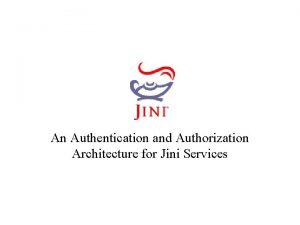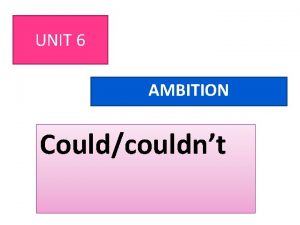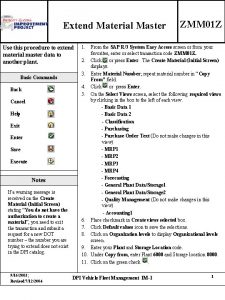Could Jiro Extend the Jini Pattern Lanuguage Anthony












- Slides: 12


Could Jiro™ Extend the Jini™ Pattern Lanuguage? Anthony Earl, Ph. D. Jiro Consultant Sun Microsystems Inc. (SMI) For the OOPSLA workshop on the Jini Pattern Language in Minneapolis, 15 th October 2000 scheduled for technical 15 minutes + 5 for questions

Overview • What is Jiro for? • Jiro pieces in Common with Jini • Where Jiro extends Jini (I) • Example Station Sequence • Where Jiro extends Jini (II) • Jiro References • Questions

What is Jiro for? • Jiro is SMI's implementation of the Federated Management Architecture (FMA) • The FMA was developed as part of the Java™ Community Process (JCP) to describe interfaces for building software components to manage heterogeneous storage networks. • Jiro is to Storage Management architectures what Enterprise Java

Jiro pieces in Common with Jini. The Jiro implementation takes advantage of Jini by using some of its interfaces and implementation code (not a requirement of the FMA). These parts of Jiro are parts of Jini: • Leasing • Lookup Service • Transaction Service Valid in Jiro ==> valid in Jini

Where Jiro extends Jini (I) Stations include: • Acceptor-Referent pattern(? ) supports: – Remote static invocation – Remote constructors – Context mechanism for security, transactions, controllers and logical threads • Remote deployment of services – Get the jar files into the right locations with the right RMI-codebase property set.

Example Acceptor-Referent Sequence (I) GOAL: Instantiate a remote Jiro-aware object. 1/ Client instantiates a Proxy using any one of the available constructors. The last argument of the constructor is the station address of the station that is to host the referent object. 2/ The Proxy class will need to lookup an appropriate Station Proxy by querying a

Example Acceptor-Referent Sequence (II) 3/The Proxy extracts context information to be passed explicitly to the Station Proxy. 4/ The Proxy class passes the operation request to the Station Proxy 5/ The Station Proxy forwards the request to the Station 6/ The Station uses the explicitly passed context information to establish a

Example Acceptor-Referent Sequence (III) 8/ The Station must now create an Acceptor for the new Referent object 9/ The newly created Acceptor is returned to the Proxy as an Acceptor embedded in a binding information object 10/ The Proxy then binds the returned Acceptor. All remote method invocations on the Proxy will now be forwarded through the Acceptor to the

Where Jiro extends Jini (II) • Extended Services Event Service – – Instead of 1 -n source-listeners there is n-1 -n sourcesservice-observers/responsibles • New Services – Logging of messages – Scheduling of events – Persistence of services – Security (based on JAAS) of method calls – Controllers and Logical Threads

Jiro References • http: //jiro. com is the place for Jiro resources. • There are no published Jiro books (such work is in progress).

Jiro™ Technology Questions
